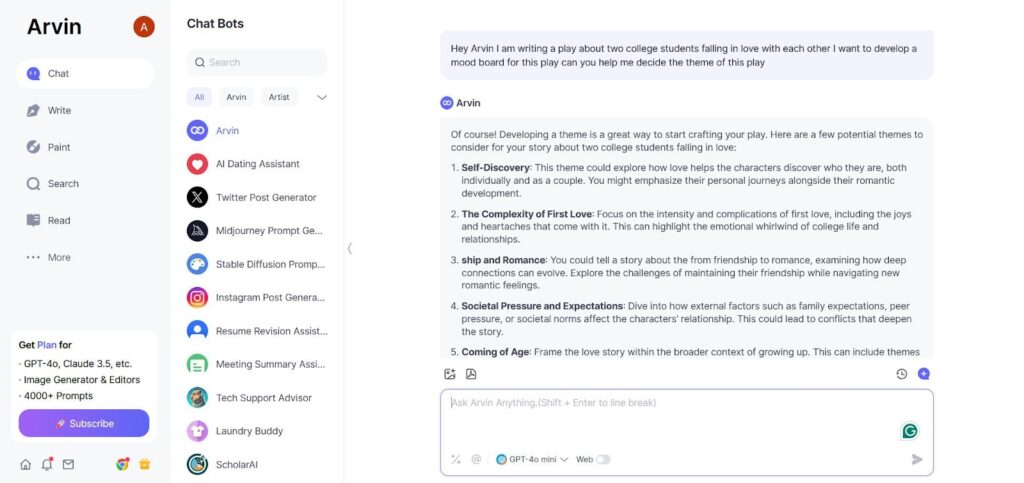Have you ever wondered how to write a play that keeps audiences glued to their seats? The kind that makes them laugh, gasp, or maybe even shed a tear? If you’ve ever watched a play and thought, “I could write something like this,” then you’re in the right place. But where do you start learning how to write a play? This guide will show you exactly how to write a play, from brainstorming ideas to getting it on stage. So, grab a notebook (or finally open that blank document staring at you), and let’s get started.

What Is Playwriting?
So, you want to know how to write a play? Great choice! But before you start, let’s get one thing straight; playwriting is a whole different thing compared to writing a book or a movie script. A play is a live storytelling experience. There are no fancy camera angles and no dramatic slow-motion effects. Everything happens in real time, right in front of an audience. The magic? It’s all in the words, the emotions, and the way actors bring the script to life.
Instead of writing long paragraphs describing how a character feels, you show it through dialogue, actions, and stage directions. So your script is the guide, but it’s up to the actors, directors, and stage crew to build the final masterpiece.
What Are The Different Types of Plays?
Not all plays are created equal. Some will make you laugh, others will make you cry, and some might leave you scratching your head (in a good way). Here’s a breakdown of the main types of plays you need to know about if you want to know how to write a play:
Drama:
This is your go-to if you love deep emotions, intense conflicts, and thought-provoking stories. Dramas deal with real-life struggles like love, loss, betrayal. If you’ve ever seen Hamlet or Death of a Salesman, you know what drama is all about.
Comedy:
Do you love to make people laugh? Then a comedy might be your best bet. Comedies focus on humor, misunderstandings, and exaggerated characters. Whether it’s witty dialogue, slapstick humor, or clever satire, the goal is to keep the audience entertained. Shakespeare’s “A Midsummer Night’s Dream” is a good example of a comedy play.
Tragedy:
If you enjoy gut-wrenching, tear-jerking stories, tragedy is your genre. Tragedies usually follow a character with a fatal flaw that leads to their downfall (cue dramatic music). Romeo and Juliet? That’s an example of a classic tragedy because everyone’s miserable at the end (you too, right?)
Musical:
Love storytelling through songs? Musicals combine dialogue, music, and dance to tell a story. They can be fun, emotional, or even dramatic but keep in mind that writing a musical means working with composers and lyricists (unless you’re a songwriting genius).
Experimental:
Feeling bold? Experimental plays break traditional rules. They might mess with time, and space, or even involve the audience in unexpected ways. If you’ve ever seen a play where actors suddenly start talking to the audience or switching characters mid-scene, you’ve witnessed experimental theater in action.
Which One Should You Choose?
Well, there’s no right or wrong answer. The type of play you write depends on the story you want to tell. Want to explore human emotions? Go for drama. Want to poke fun at society? Comedy. Want to make people cry? Tragedy. The important thing is to pick a format that excites you because if you love writing it, your audience will love watching it.

How To Write A Play: Our Step-By-Step Guide
Now that you know the basics, let’s help you learn how to write a play step-by-step in easy-to-follow steps:
Step 1: Choosing a Concept and Theme
The first step of how to write a play is to choose a theme. Every great play starts with a single spark, like an idea that refuses to leave your brain. But how do you find that spark? How do you choose a story that will keep an audience engaged from the first line to the final curtain call? Let’s help you find your big idea.
Finding Your Big Idea
Start by asking yourself:
- What do I care about?
- What kind of stories excite me?
- Is there a message I want to share?
Some of the best plays come from real-life experiences, historical events, or social issues. Others come from pure imagination. There’s no rule here so your play can be anything you want it to be!
If you’re stuck, try these idea-generating tricks:
- Eavesdrop on conversations (politely, of course). Real-life dialogues are the best ones you can get.
- Read the news because the truth is often stranger than fiction.
- Ask “What if?” What if a group of strangers got locked in a theater overnight? What if a time traveler accidentally altered history?
- Take help from an AI writing assistant like Arvin AI to generate ideas.

Step 2: Developing Your Characters
Characters are the heartbeat of any play. If they’re boring, your audience won’t care about your play. But if they’re real, flawed, and unforgettable, people will talk about your play long after the curtain closes.
Who’s Who in Your Play?
Most plays include these key players:
- The Protagonist: This is your main character; the one who drives the story.
- The Antagonist: The force working against the protagonist (it can be a villain, society, or even their own doubts).
- Supporting Characters: These are friends, family, or sidekicks who add depth to the story.
Think about what your characters want. Every great character has a goal, whether it’s love, revenge, freedom, or just a good cup of coffee. The more they want something, the more interesting the story becomes.
Pro Tip: Use a character name generator to create unique names for your characters instead of the same old boring names.
Make Your Characters Feel Real
Want your characters to feel like real people? Give them:
- A distinct voice because no two characters should sound the same
- Flaws and contradictions because perfect people are boring (and let’s be honest, perfect people don’t exist)
- Memorable quirks (Maybe your character always talks in metaphors or refuses to use contractions)
And most importantly, don’t just tell us who they are but instead show us! Instead of writing, “She’s nervous,” have her bite her nails or fidget with her sleeves. Remember, actions speak louder than words!

Step 3: Structuring Your Play
If you want to learn how to write a play without a structure, you’ll get lost fast. Most plays follow the Three-Act Structure, so let’s talk more about it:
Act 1: The Setup
- Introduce your characters and setting.
- Show the main character’s world before things go wrong.
- End with an inciting incident (yes, the moment that changes everything!)
For Example: In Romeo and Juliet, Act 1 ends with the two lovers meeting and falling for each other.
Act 2: The Conflict
- The protagonist faces challenges and obstacles.
- Tension builds and things get worse.
- This act is usually the longest and should keep the audience on edge.
Act 3: The Resolution
- Finally, it’s time for the climax, the moment when everything comes to a head.
- The big question gets answered (Will they win? Will they survive?).
- Wrap things up in a satisfying way.
If your play is a one-act, you still need a clear beginning, middle, and end but just in a shorter format!

Step 4: Writing Engaging Dialogue
If your dialogue is boring, your play is doomed. So you need dialogues that sound natural but grab attention at the same time. Here’s how to write natural dialogues so that you can learn how to write a play:
- Keep it short and snappy because real people don’t speak like speech topics.
- Cut unnecessary words so that every line should move the story forward.
- Use subtext because characters don’t always say exactly what they mean.
Bad Example:
JANE: I am very sad because my boyfriend broke up with me.
Good Example:
JANE: (staring at her phone, fake smile) Wow. He moved on fast.
See the difference? The second version shows Jane’s emotions instead of telling.

Step 5: Stage Directions And Formatting
Stage directions are like little whispers to the actors and director, telling them how a scene should play out. But here’s the trick: less is more. If you overdo it, you’re basically trying to control every blink and breath and that’s not fun for anyone. Here’s how to write a play with clear stage directions:
- Keep them short and useful; only include what’s necessary.
- Show action and emotion, not micromanage every movement.
- Trust the actors and director to bring your script to life.
Pro Tip: Stage directions should be written in present tense and italicized in the script. This makes it clear they aren’t spoken words.
Step 6: Revising and Editing Your Play
Congratulations! You’ve finished your first draft so now you know how to write a play. But the real work begins now. It’s time to cut, polish, and refine.
Editing Checklist:
- Does every scene serve a purpose?
- Is the dialogue engaging?
- Are characters consistent and believable?
- Is the pacing smooth?
Plays are meant to be heard, not just read. Gather some friends and read your script out loud. You’ll instantly notice what works and what feels clunky. Then, you can get feedback from other writers or actors to improve your work. Once you’ve made your edits, read it again and again and again. Polish it until every word feels just right.

Step 7: Bringing Your Play to Life
So, you’ve written, edited, and polished your masterpiece. Now what? A play isn’t meant to sit in a drawer; it’s meant to be performed! Here’s how you can bring your script to life:
- Stage a reading: Gather friends and have them read it aloud.
- Submit to theaters: Many theaters and writing competitions accept new plays so this could be your chance to get noticed!
- Self-produce: Rent a small space and put on your own show. You can use social media to promote your play.
And there you have it! Now you know how to write a play, and you’re ready to bring your imagination to life.

FAQS About How To Write A Play
Here are a few of the most frequently asked questions about how to write a play:
How do you start writing a play?
To start writing a play, begin with a strong idea or theme that excites you. Develop compelling characters with clear motivations and outline the structure, whether it’s a one-act or a full three-act play. Start your script with an engaging opening scene that grabs attention, and focus on natural dialogue that moves the story forward. Keep stage directions minimal but effective.
What is the structure of writing a play?
A play typically follows a three-act structure: Act 1 introduces the characters and conflict, Act 2 builds tension and deepens the story, and Act 3 delivers the resolution. However, some plays use a two-act or even one-act structure, depending on the story being told.
How long should a play be?
It depends on the type of play. A full-length play usually runs between 70 to 120 minutes, while one-act plays are typically 10 to 45 minutes long. Short plays, also called 10-minute plays, are even more concise. The key is to ensure the length serves the story and keeps the audience engaged.
What’s the difference between a play and a screenplay?
A play is written for the stage, focusing on live performances, dialogue-driven storytelling, and minimal scene changes. A screenplay is for films or TV and includes camera angles, visual effects, and multiple locations. While both require strong storytelling skills, they follow different formats and techniques.
You Now Know How to Write a Play!
And there you have it! You now know exactly how to write a play, from crafting unforgettable characters to structuring scenes that keep audiences hooked. It might have seemed daunting at first, but with the right approach (and a little creativity), you’re well on your way to writing a play that deserves a standing ovation.
And if you ever feel stuck, need inspiration, or want help refining your script, Arvin AI is here to make the writing process smoother and more exciting. Use it to enhance your essay or to write your wedding toasts; we don’t mind! Now go break a leg!






